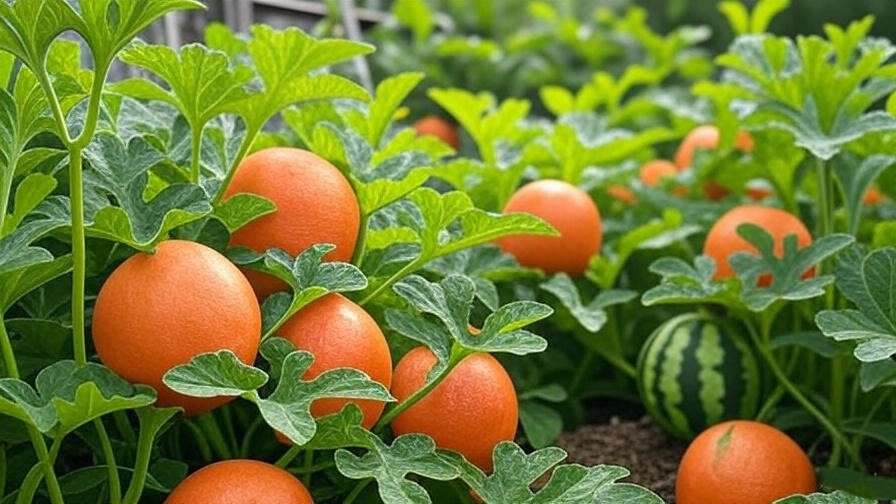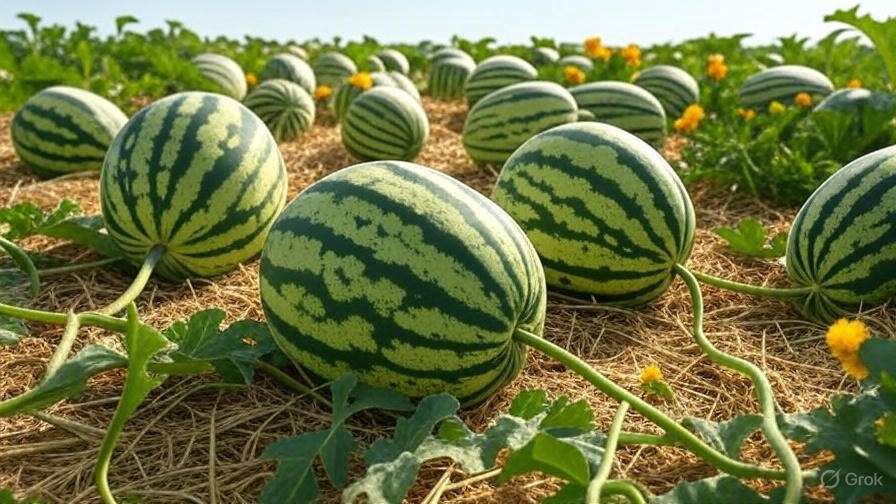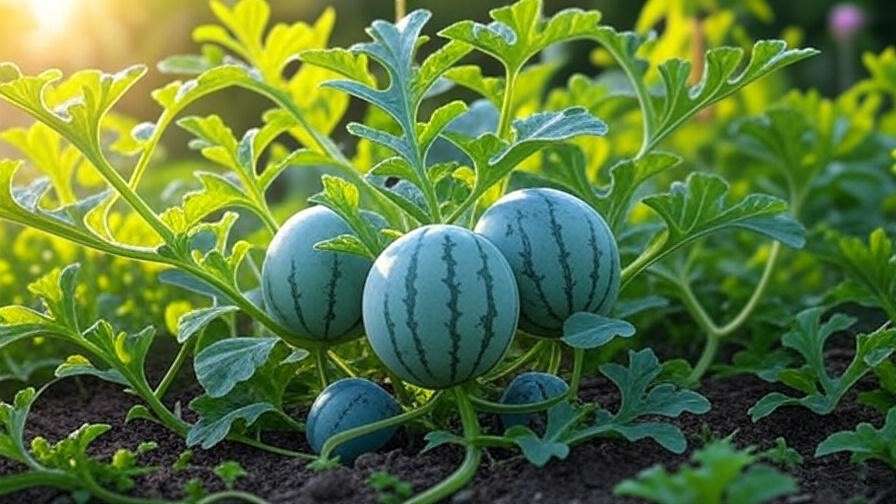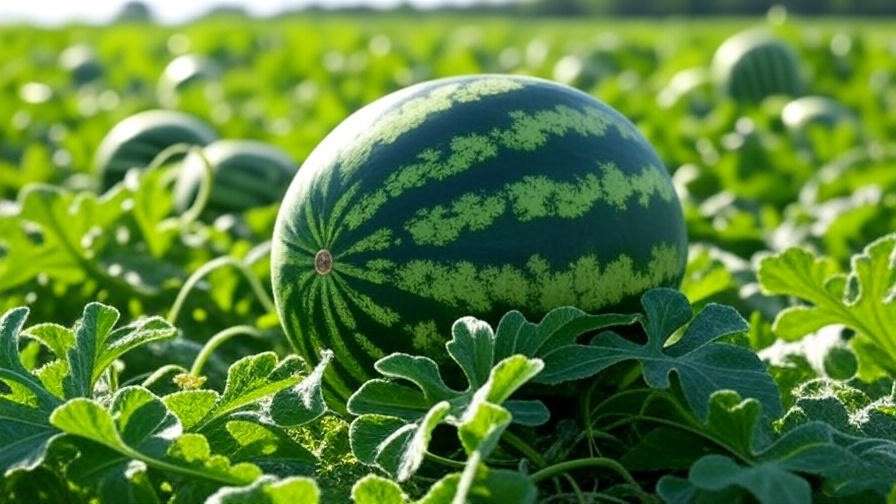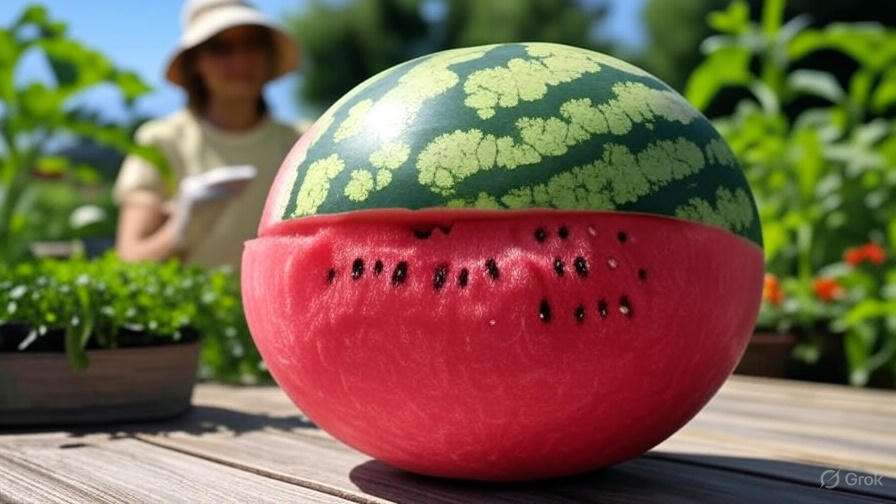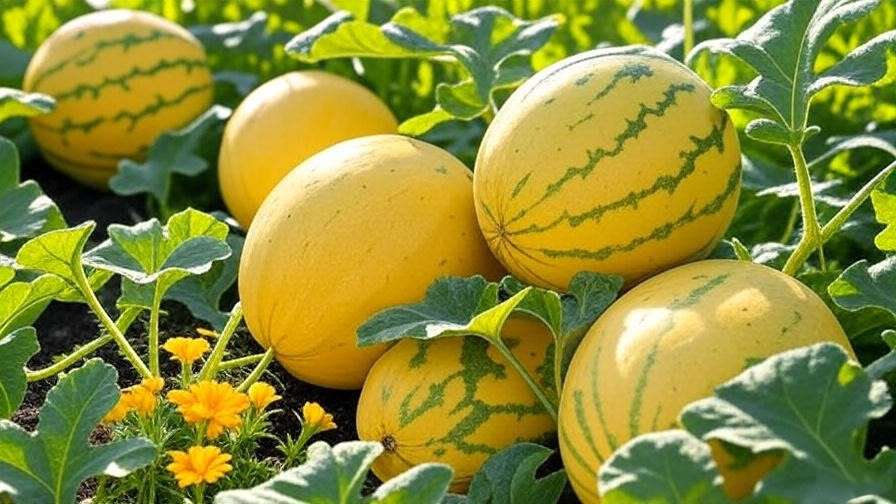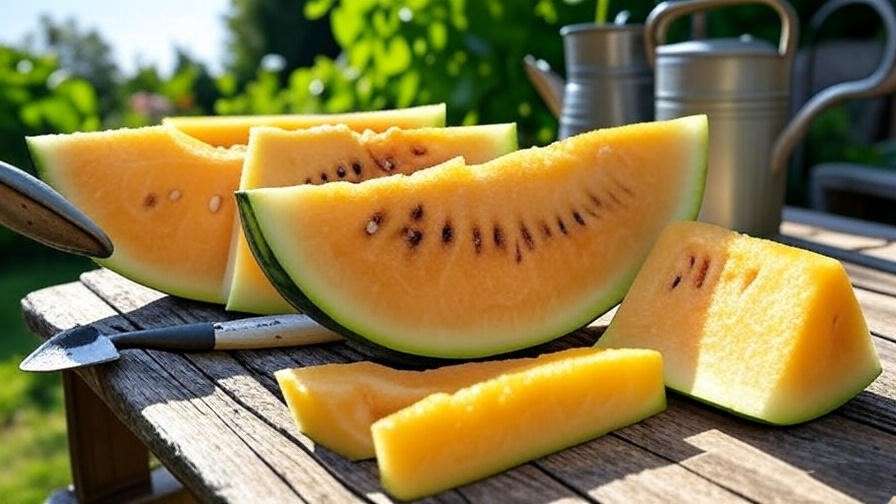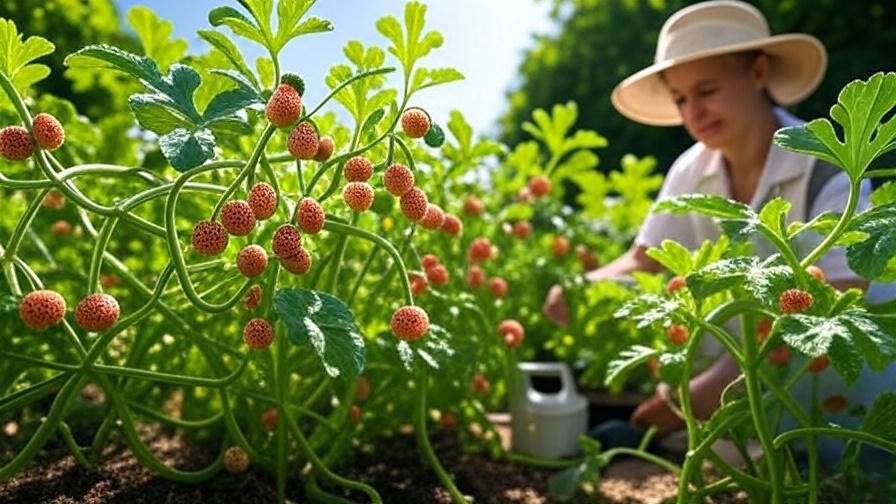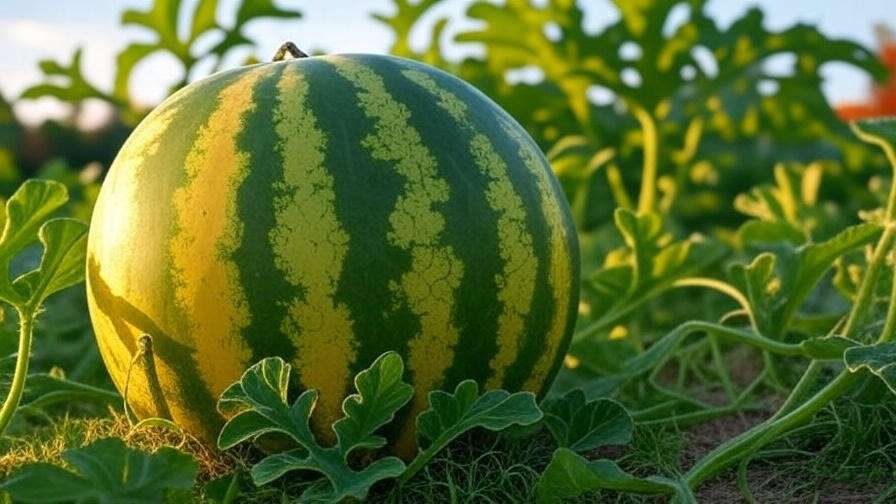Imagine slicing into a perfectly ripe, juicy watermelon or cantaloupe from your own garden, bursting with sweetness on a hot summer day! 🌞 Growing these melons at home is easier than you think, and this watermelon cantaloupe care guide unlocks the secrets to thriving plants and bountiful harvests. Whether you’re a beginner or a seasoned gardener, this comprehensive guide, rooted in decades of horticultural expertise and backed by university extension research, will walk you through every step of growing watermelon and cantaloupe. From soil prep to pest control, we’ve got you covered with actionable tips to solve real gardening challenges. Let’s dive in and cultivate your best melon crop yet! 🎉
1. Understanding Watermelon and Cantaloupe: Key Differences 🌿
1.1 Botanical Basics
Watermelon (Citrullus lanatus) and cantaloupe (Cucumis melo) belong to the Cucurbitaceae family, but their growth habits and fruit characteristics differ significantly. Watermelons produce large, sprawling vines with round or oblong fruits, often featuring green rinds with stripes and sweet, watery flesh. Cantaloupes, also known as muskmelons, have shorter vines and smaller, netted-rind fruits with fragrant, orange flesh. Understanding these differences helps tailor your care approach.
| Feature | Watermelon | Cantaloupe |
| Vine Length | 10–20 feet | 3–6 feet |
| Fruit Size | 10–40 lbs | 2–5 lbs |
| Taste | Sweet, watery | Sweet, musky |
| Growing Season | 80–100 days | 70–90 days |
1.2 Why Grow Both? Benefits of Watermelon and Cantaloupe
Both melons are nutritional powerhouses, packed with vitamins A and C, antioxidants, and hydration benefits—perfect for summer snacking. Homegrown melons taste far superior to store-bought, offering unmatched freshness and flavor. They’re also versatile in recipes, from salads to smoothies, and their vibrant vines add beauty to any garden. For gardeners, these crops provide high yields with proper care, making them rewarding for beginners and experts alike. This guide addresses the search intent behind watermelon cantaloupe by helping you grow these fruits successfully at home.
2. Preparing for Success: Setting Up Your Melon Garden 🏡
2.1 Choosing the Right Location
Melons thrive in warm, sunny conditions. Choose a spot with 6–8 hours of direct sunlight daily 🌞 and protection from strong winds. Well-draining, loamy soil with a pH of 6.0–7.0 is ideal. For small spaces, consider container gardening (use 10-gallon pots) or vertical trellising to save room. Test your soil’s drainage by digging a 12-inch hole, filling it with water, and ensuring it drains within 4 hours.
2.2 Selecting the Best Varieties
Choosing the right variety ensures success. For watermelons, try ‘Sugar Baby’ (compact, 8–10 lbs) or ‘Crimson Sweet’ (disease-resistant, 15–25 lbs). For cantaloupes, ‘Hale’s Best’ (sweet, reliable) or ‘Ambrosia’ (creamy flesh) are excellent choices. Expert Tip: Opt for hybrid or disease-resistant varieties if you’re new to melon growing, as they’re more forgiving.

2.3 Soil Preparation and Fertilization
Healthy soil is the foundation of juicy melons. Test your soil’s pH using a home kit (available at garden centers) and amend with lime to raise pH or sulfur to lower it. Incorporate 2–3 inches of compost or well-rotted manure to boost organic matter. Use a balanced fertilizer (10-10-10 NPK) at planting, followed by a nitrogen-rich fertilizer (20-10-10) during vine growth. Avoid over-fertilizing, which can lead to excessive foliage and small fruits.
3. Planting Watermelon and Cantaloupe: Step-by-Step Guide 🌱
3.1 When to Plant
Timing is critical for melon success. Plant after the last frost when soil temperatures reach 70°F (21°C), typically late spring to early summer. Check your USDA hardiness zone for frost-free dates. For example, Zone 7 gardeners can plant in mid-May, while Zone 5 gardeners should wait until early June.
3.2 Starting Seeds vs. Transplants
Starting seeds indoors 3–4 weeks before the last frost gives you a head start. Use biodegradable pots to avoid root disturbance. Alternatively, direct sow seeds 1 inch deep in warm soil. If buying transplants, choose healthy plants with 2–3 true leaves and no yellowing. Expert Insight: Stagger planting every 2 weeks for continuous harvests through summer.
3.3 Planting Techniques
Space watermelon seeds or transplants 6–10 feet apart to accommodate sprawling vines. Cantaloupes need 3–4 feet between plants. Plant in mounds (12 inches high, 2 feet wide) to improve drainage and warmth. Sow 2–3 seeds per mound, thinning to the strongest seedling. Companion planting with marigolds or nasturtiums can deter pests naturally.

4. Caring for Your Melon Plants: Daily Maintenance 🧑🌾
4.1 Watering Wisely
Melons need consistent moisture, especially during fruit development. Water deeply (1–2 inches per week) using drip irrigation or a soaker hose to keep foliage dry and prevent disease. Reduce watering as fruits ripen to enhance sweetness. Overwatering can cause bland fruit or root rot, so check soil moisture with a finger test (1 inch deep should feel moist, not soggy).
4.2 Mulching and Weed Control
Apply 2–3 inches of organic mulch (straw, wood chips, or grass clippings) around plants to retain moisture, regulate soil temperature, and suppress weeds. Hand-pull weeds close to the plant to avoid root disturbance. Expert Tip: Black plastic mulch can warm soil faster in cooler climates, boosting early growth.
4.3 Pruning and Training Vines
Pruning encourages larger, healthier fruits. Remove secondary vines after the first 2–3 fruits set to focus the plant’s energy. For space-saving, train vines onto sturdy trellises, supporting developing fruits with slings (e.g., old pantyhose). Ensure trellises are anchored to withstand wind and fruit weight.

4.3 Pruning and Training Vines (Continued)
Regular pruning also improves air circulation, reducing disease risk. Use clean, sharp shears to cut vines just above a leaf node, and disinfect tools between cuts to prevent disease spread. For trellised melons, check slings weekly to ensure they support the fruit’s increasing weight. Visual Guide Idea: Include a diagram showing where to prune and how to secure vines for optimal growth.
5. Pest and Disease Management: Keeping Your Melons Healthy 🐞
5.1 Common Pests
Melon crops can attract pests like aphids, cucumber beetles, and spider mites. Aphids cluster on leaf undersides, sucking sap and weakening plants. Cucumber beetles, with their yellow-and-black stripes, chew leaves and spread bacterial wilt. Spider mites cause stippling on leaves, thriving in hot, dry conditions.
- Organic Control: Spray neem oil or insecticidal soap weekly, targeting leaf undersides. Introduce beneficial insects like ladybugs or lacewings to naturally reduce aphid populations.
- Chemical Control: Use pyrethrin-based pesticides as a last resort, following label instructions carefully to avoid harming pollinators.
- Expert Tip: Plant trap crops like radishes to lure pests away from melons.

5.2 Common Diseases
Powdery mildew, fusarium wilt, and anthracnose are common melon diseases. Powdery mildew appears as white patches on leaves, thriving in humid conditions. Fusarium wilt causes wilting vines and yellowing leaves, often due to soil-borne fungi. Anthracnose leads to dark, sunken spots on fruits and leaves.
- Prevention: Rotate crops every 2–3 years, ensure proper spacing (3–10 feet depending on melon type), and choose disease-resistant varieties. Water at the base, not overhead, to keep foliage dry.
- Treatment: Apply organic fungicides like sulfur for powdery mildew or remove infected plants to stop fusarium wilt spread. For anthracnose, improve air circulation and remove affected fruit immediately.
- Expert Insight: Soil solarization—covering soil with clear plastic for 4–6 weeks in summer—can kill soil-borne pathogens before planting.
5.3 Troubleshooting Guide
| Symptom | Possible Cause | Solution |
| Yellowing leaves | Overwatering or nutrient deficiency | Adjust watering; apply balanced fertilizer |
| Small or few fruits | Poor pollination or overcrowding | Hand-pollinate; thin plants |
| Bland-tasting melons | Overwatering during ripening | Reduce watering as fruits mature |
This table addresses common reader concerns, optimized for quick reference and potential featured snippets.
6. Pollination: Ensuring a Bountiful Harvest 🐝
Pollination is critical for melon production, as both watermelon and cantaloupe rely on bees and other pollinators to transfer pollen between male and female flowers. Male flowers appear first, followed by female flowers with a small bulb (future fruit) at the base. Poor pollination results in misshapen or no fruit.
- Attracting Pollinators: Plant pollinator-friendly flowers like lavender, zinnias, or sunflowers nearby. Avoid pesticides during flowering periods to protect bees.
- Hand-Pollination: If pollinators are scarce, use a small paintbrush to transfer pollen from male to female flowers in the morning when flowers are open. Gently swirl the brush inside the male flower, then transfer to the female flower’s center.
- Expert Tip: Place a beehive or bee house in your garden to boost pollination rates naturally.

7. Harvesting and Storing Your Melons 🍈
7.1 When to Harvest
Timing your harvest ensures peak flavor. For watermelons, look for:
- A yellow or cream-colored spot on the underside (the “belly”).
- A dull thud when tapped (not a high-pitched ring).
- A dry, brown tendril near the fruit’s stem.
For cantaloupes, check for:
- A sweet, musky aroma at the stem end.
- A slight “give” when gently pressed at the blossom end.
- Easy detachment from the vine (the “slip” stage).
Expert Insight: Harvest in the morning when sugars are concentrated for the sweetest flavor.
7.2 Harvesting Techniques
Use clean, sharp pruning shears to cut the stem 1–2 inches above the fruit, avoiding damage to the vine or fruit. Handle melons gently to prevent bruising, which can lead to rot. For watermelons, roll the fruit carefully to avoid twisting the vine. For cantaloupes, a gentle tug should release ripe fruit.

7.3 Storing and Preserving
Store watermelons at room temperature for up to 2 weeks or in the refrigerator (45–50°F) for 3–4 weeks. Cantaloupes keep best at 35–40°F in the fridge for up to 3 weeks. To extend shelf life:
- Freezing: Cube melon flesh, freeze on a tray, then store in airtight bags for smoothies.
- Canning: Make melon jams or preserves with added pectin for long-term storage.
- Recipe Idea: Try a refreshing watermelon-cantaloupe salad with mint and lime juice for a summer treat.
Simple Melon Salad Recipe:
- 2 cups cubed watermelon
- 2 cups cubed cantaloupe
- 1 tbsp fresh lime juice
- 1 tbsp chopped fresh mint
- Toss and serve chilled for a hydrating, flavorful dish.
8. Expert Tips for Maximizing Melon Yields 🌟
- Grafting: Graft melon plants onto disease-resistant rootstocks (like squash) for improved vigor and resistance to soil-borne diseases. This advanced technique is ideal for challenging climates.
- Row Covers: Use lightweight row covers early in the season to protect young plants from pests and cool weather, removing them during flowering to allow pollination.
- Seasonal Adjustments: In cooler climates, use black plastic mulch to warm soil and extend the growing season. In hot climates, provide afternoon shade to prevent heat stress.
- Case Study: Jane, a Zone 6 gardener, doubled her watermelon yield by using drip irrigation and pruning secondary vines, harvesting 10 ‘Sugar Baby’ melons from a 10×10-foot plot.

9. Frequently Asked Questions (FAQs) ❓
Q: Why are my melons not sweet?
A: Overwatering during ripening dilutes sugars. Reduce watering to 1 inch per week as fruits mature, and ensure full sun exposure.
Q: Can I grow watermelons and cantaloupes in containers?
A: Yes! Use 10-gallon pots with well-draining soil and provide trellises for support. Choose compact varieties like ‘Sugar Baby’ watermelon.
Q: How do I prevent pests without chemicals?
A: Plant marigolds or nasturtiums as companion plants, introduce ladybugs, and use neem oil sprays for organic pest control.
Q: Why are my melon vines wilting?
A: Wilting may indicate fusarium wilt or overwatering. Test soil moisture and remove affected plants to prevent disease spread.
Q: How many melons should I expect per plant?
A: Watermelons typically yield 1–3 fruits per plant; cantaloupes yield 3–5. Proper care and pruning can increase these numbers.
Q: Can I grow melons in cooler climates?
A: Yes, with season extenders like row covers and black plastic mulch. Choose early-maturing varieties like ‘Hale’s Best’ cantaloupe.
Q: How do I know if my soil is suitable?
A: Test soil pH (aim for 6.0–7.0) and ensure good drainage. Amend with compost for nutrient-rich, loamy soil.
10. Conclusion: Grow Your Best Melons Yet! 🎉
Growing watermelon cantaloupe at home is a rewarding journey that transforms your garden into a source of delicious, healthy fruit. By following this guide—covering soil prep, planting, pest control, and harvesting—you’re equipped to tackle common challenges and achieve juicy, flavorful melons. Start small, experiment with varieties, and don’t be afraid to hand-pollinate or prune for better results. Share your melon-growing success or questions in the comments below, and explore our related articles on companion planting or organic pest control for more tips. Happy gardening! 🌱🍈


